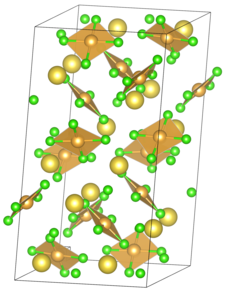 | |
| Names | |
|---|---|
| IUPAC name
Sodium tetrachloroaurate (III)
| |
| Other names
Sodium gold chloride, yellow gold chloride
| |
| Identifiers | |
3D model (JSmol)
|
|
| ChemSpider | |
| ECHA InfoCard | 100.035.659 |
| EC Number |
|
PubChem CID
|
|
| UNII | |
CompTox Dashboard (EPA)
|
|
| |
| |
| Properties | |
| NaAuCl4 | |
| Molar mass | 361.756 g/mol |
| Appearance | Orange powder |
| Density | 3.81 g cm−3[2] |
| anhydrous: 139g/100ml (10°C) 151g/100ml (20°C) 900g/100ml (60°C) [3] | |
| Solubility | Sparingly soluble in diethyl ether,[4] soluble in alcohol, ether [3] |
| Hazards[5] | |
| GHS labelling: | |
 
| |
| Danger | |
| H315, H319, H335 | |
| P261, P264, P271, P280, P302+P352, P304+P340, P305+P351+P338, P312, P330, P332+P313, P333+P313, P337+P313, P363, P403+P233, P405, P501 | |
Except where otherwise noted, data are given for materials in their standard state (at 25 °C [77 °F], 100 kPa).
| |
Sodium tetrachloroaurate is an inorganic compound with the chemical formula NaAuCl4. It is composed of the ions Na+ and AuCl4−. It exists in the anhydrous and dihydrate states. At room temperature, it exists as a golden-orange solid. The anhydrous and dihydrate forms are available commercially.[1]